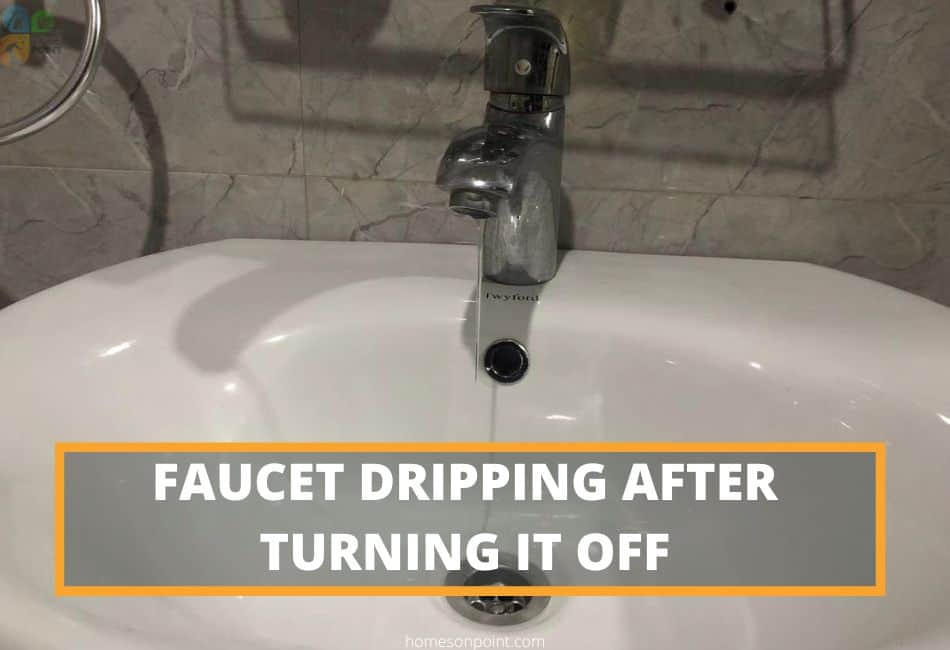You’re done with your sink faucet. You turn it off and… dripping. What’s going on? Why does my faucet drip after I turn it off? And, more importantly, how do I stop it from leaking? Those are all valid questions, and we will answer them in this blog post.
Some leakages are undetectable to the eye until signs of water damage become evident. This is not the case with dripping faucets, which are apparent as soon as they start.
Dangers Of Dripping Faucets
A dripping faucet is annoying and comes with the following issues:
1. Dripping Faucets Wastes Water
A dripping faucet is not only annoying, but it’s also a waste of water. According to the EPA, approximately 10% of households in the United States have leaks that waste 90 gallons or more of water each day. That’s a lot of water. A faucet dripping at one drop per second can waste more than 3000 gallons of water per year, the amount needed to take about 180 showers. If a faucet leans at ten drips per minute, that faucet can waste more than 500 gallons annually. So, not only is dripping water annoying, but it’s also bad for the environment because it wastes a valuable resource.
2. Dripping Faucets Will Cause You To Lose Money
In addition to wasting water, dripping faucets will cause you to lose money. That’s because the water dripping from your faucet is water you’re paying for. So, if you have a dripping faucet, you’re throwing money down the drain.
3. Dripping Faucets Increase Moisture Causing Molds
Another danger of dripping faucets is that they can increase moisture, leading to mould and mildew growth. Constant dripping from the faucet means your sink will never have a chance to dry out completely, which creates the perfect environment for mould to grow in your sink. These growths are harmful to your health and shouldn’t be taken lightly.
Reasons Why Your Faucet Is Dripping After Turning It Off
Dripping faucets might appear suddenly, and you might wonder what you did to cause it. Sometimes, they even stop dripping and then come back again. There are several reasons why your faucet might drip after you turn it off.
1. A Worn-Out Washer
Washers are small, round pieces of rubber or fibre that create a tight seal between the moving parts of your faucet to prevent leaks. Over time, these washers can become worn out and no longer create a seal, causing the facet to begin leaking. When this happens, no matter how hard you turn the faucet handle to stop the leak, it drips. Sometimes, turning it too hard might even cause the washer to break, making the dripping worse.
The good news is that replacing a washer is a relatively easy and inexpensive fix. You can either do it yourself or hire a professional to do it for you.
If you’re handy and want to try fixing it yourself, here are some instructions on replacing a washer.
- First, you’ll need to turn off the water to your sink. The easiest way to do this is to turn off the main water supply to your home.
- Once the water is off, open up the faucet to release any remaining water in the line and block the sink drain to prevent small parts from going down the hole.
- Next, use a flat screwdriver to remove the handle cover to reveal the screws holding the handle. Then, use a screwdriver to unscrew them to remove the handle.
- Once the handle is removed, remove the retaining nut holding the valve stem in place. Now, you should be able to pull out the valve stem and washer.
- Remove the old washer and take it to the store so you can find a replacement that’s the same size.
- Once you have the new washer, put it in place and reassemble the faucet.
- Turn on the water and check for leaks. If there are no leaks, you’ve successfully fixed the dripping faucet.
2. Damaged Or Corroded Valve Seat
Another reason your faucet might be dripping is that the valve seat, which is the part of the faucet that the washer sits on, is damaged or corroded. When this happens, it causes the washer to not create a seal, which leads to dripping.
You might be asking yourself how the valve seat could become damaged or corroded. It can happen over time because of mineral deposits that build up on it. When these deposits build up, it causes the valve seat to become misshapen.
A faulty washer might have also allowed the metal stem to grind against the valve seat, causing further harm.
If the valve seat is damaged, you’ll need to replace it. This is a more difficult fix than replacing a washer and will require you to disassemble the faucet. We recommend hiring a professional to do this for you.
3. Bad O-Ring
The O-ring is popular in cartridge-style faucets. It’s a small but important part of your faucet. It is a rubber ring that’s located under the handle. It fits snugly around the stem screw, helps secure the handle in place, and creates a watertight seal.
After prolonged use, which is usually the case, the o-ring can become worn out leading to dripping around the handle. If you notice dripping around the handle, then it’s most likely due to a bad O-ring.
You can attempt to fix this problem yourself by removing the handle and replacing the O-ring. If you’re uncomfortable doing this or can’t seem to fix the problem, we recommend hiring a professional.
To fix it yourself, follow these steps:
- First, turn off the water supply to your faucet.
- Close the sink drain so you don’t lose any small parts down the drain.
- Next, remove the handle by unscrewing the screw that’s holding it in place. Once the handle is off, you should be able to see the O-ring.
- Remove the old O-ring with your fingers and replace it with the new one. O-rings come in different diameter sizes, so make sure to get one that’s the same size as the old one.
- Once you’ve replaced the O-ring, reassemble the faucet and turn on the water. Test for leaks by turning on the sink and checking for dripping around the handle. If there is no dripping, then you’ve fixed the problem
4. Improper installation
In some cases, dripping can be due to improper installation. When a faucet isn’t installed correctly, it can cause all sorts of problems, the major one being dripping.
Improper installation can happen when the washer isn’t installed correctly, or the O-ring is not properly placed. When the washer and O-rings are not the right sizes or not installed correctly, it will cause dripping.
This can also happen if the packing nut, which is the nut that secures the faucet to the sink, is too tight or not tight enough.
A professional plumber is always your best bet when it comes to installation if you want to say bye-bye to dripping faucets.
5. Worn-Out Cartridge
Sink faucets are not universal. They come in different types, including cartridge-style faucets. If you have faucets with two handles, one for hot water and one for cold, then you may have a cartridge-style faucet. The cartridge is what controls the flow of water in your faucet. It’s a cylindrical piece that’s located under the handle.
Some cartridge faucets don’t use washers, like the quarter-turn faucets. As the handle is turned, a small disc inside the faucet turns, allowing water to flow.
When the cartridge becomes worn out, it will cause dripping because it can no longer control the water flow correctly. Follow these simple steps to replace worn-out cartridges.
- First, shut off the valve to stop the flow of water and turn on the faucet to drain any remaining water.
- Next, close your sink drain so you don’t lose any small parts.
- Remove the faucet handle by unscrewing the screw that’s holding it in place. With some handles, you will have to pop off the handle caps with a flat screwdriver before you can access the screws.
- Once the handle is off, you should be able to see the cartridge. Remove the bonnet nut with a wrench and pull out the cartridge. You can use a plier to help remove the cartridge.
- Replace the old cartridge with a new one and make sure it’s properly seated in the faucet body. Use an exact cartridge match for your faucet.
- Reattach the bonnet nut and screw it in place with a wrench. Reattach the faucet handle and turn on the water.
- Test your faucet to see if the dripping has stopped.
6. Too Much Water Pressure
If you have too much water pressure, it can cause dripping. Normal water pressure ranges from 40 to 60 psi. If your water pressure is above the recommended level, it’s time to install a pressure-reducing valve. This will help to protect your plumbing system and keep dripping at bay.
If it is excessively high, you might just need to adjust the water pressure from the source by adjusting the source regulator if you know where it is. If you’re not sure where the source regulator is or if adjusting it doesn’t help, you should call a professional plumber.
7. Loose Parts
Dripping can also be caused by loose parts. Over time, the constant use of your faucet can cause parts to become loose. This is especially true for the screws and nuts that hold everything in place. Tightening loose parts should resolve the dripping issue.
If the dripping persists, then there is more to the problem than just loose parts.
8. Not Closing The Valve Properly
The valve is what controls the flow of water to your faucet. If the valve isn’t closed properly, it can cause dripping. This is because water will continue to flow even when the faucet is turned off. This is a temporary cause of dripping and can be easily fixed by properly closing the valve.
Summary
If your faucet is dripping, it’s important to identify the cause so you can fix it. Dripping faucets can waste a lot of water and money, so it’s best to nip the problem in the bud. Leaking faucets can be annoying, but they don’t have to be a permanent fixture in your home. With a little bit of effort, you can say goodbye to dripping faucets for good. However, if you’re not confident in your ability to fix the problem, it’s always best to call a professional. I hope you found this resource useful. Thanks for reading.

